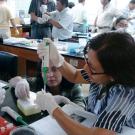Dr. Kelly Ivors from the Department of Plant Pathology at the North Carolina State University presents about the new ways to detect Phytophthora.
A direct enzyme linked immunosorbent assay (ELISA) can be used as a primary screening tool for detecting Phytophthora in plant foliage samples, although ELISA alone can not distinguish or differentiate among species. This immunologically-based assay is designed to detect any species of Phytophthora and is also reported to cross react with some species of Pythium. The intent of using ELISA as a ‘pre-screen’ is to reduce the number of samples that will need to be processed for subsequent further tests.
Detection of Phytophthora in water can be done by leaf baiting or filtration. In leaf baiting, sporangia releases swimming spores called zoospores. Zoospores are negatively geotropic and exhibit chemotaxis so they swim upwards toward leaf baits. Baiting is also a semi-selective process and only detect swimming spores. Microscopic observation for Phytophthora is initially slow, compact, and has dense colonies. Also observed are coralloid hyphae, sporangia on agar surfaces, chlamydospores, and oospores.

